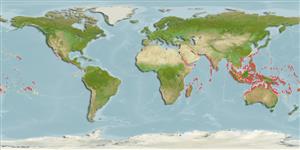>
Syngnathiformes (Pipefishes and seahorses) >
Syngnathidae (Pipefishes and seahorses) > Nerophinae
Etymology: Choeroichthys: Greek, choiros = a pig + Greek, ichthys = fish (Ref. 45335).
More on author: Bleeker.
Environment: milieu / climate zone / profondeur / distribution range
Écologie
marin récifal; profondeur 2 - 25 m (Ref. 30874). Tropical; 30°N - 30°S
Indo-Pacific: Red Sea and East Africa to the Society Islands, north to the Philippines and Guam, south to northern Australia.
Taille / Poids / Âge
Maturité: Lm ? range ? - ? cm
Max length : 7.0 cm TL mâle / non sexé; (Ref. 30874)
Description synthétique
Clés d'identification | Morphologie | Morphométrie
Épines dorsales (Total) : 0; Rayons mous dorsaux (Total) : 18 - 26; Rayons mous anaux: 4. Dark brown with parallel of small black spots in series along trunk, and some white speckles (Ref. 48635).
Body shape (shape guide): eel-like; Cross section: angular.
Occur on the continental shelf (Ref. 75154). Found in tide pool, seagrass, and coral reef areas. Ovoviviparous (Ref. 205). The males carry the eggs in a brood pouch which is found under the tail (Ref. 205). Males may be brooding at 3.5-4.0 cm SL (Ref. 5316). Also found in lagoons and seaward reefs (Ref 90102).
Life cycle and mating behavior
Maturité | Reproduction | Frai | Œufs | Fécondité | Larves
Male carries the eggs in a brood pouch (Ref. 205).
Dawson, C.E., 1985. Indo-Pacific pipefishes (Red Sea to the Americas). The Gulf Coast Research Laboratory Ocean Springs, Mississippi, USA. (Ref. 5316)
Statut dans la liste rouge de l'IUCN (Ref. 130435: Version 2025-1)
Menace pour l'homme
Harmless
Utilisations par l'homme
Pêcheries: sans intérêt
Outils
Articles particuliers
Télécharger en XML
Sources Internet
Estimates based on models
Preferred temperature (Réf.
123201): 26.1 - 29.3, mean 28.5 °C (based on 3058 cells).
Phylogenetic diversity index (Réf.
82804): PD
50 = 0.5078 [Uniqueness, from 0.5 = low to 2.0 = high].
Bayesian length-weight: a=0.00093 (0.00036 - 0.00242), b=3.05 (2.83 - 3.27), in cm total length, based on LWR estimates for this (Sub)family-body shape (Ref.
93245).
Niveau trophique (Réf.
69278): 3.4 ±0.5 se; based on size and trophs of closest relatives
Résilience (Réf.
120179): Haut, temps minimum de doublement de population inférieur à 15 mois (Preliminary K or Fecundity.).
Fishing Vulnerability (Ref.
59153): Low vulnerability (10 of 100).
🛈
Nutrients (Ref.
124155): Calcium = 250 [126, 623] mg/100g; Iron = 1.5 [0.7, 2.8] mg/100g; Protein = 17.7 [16.3, 19.2] %; Omega3 = 0.121 [0.053, 0.289] g/100g; Selenium = 46.2 [16.7, 125.3] μg/100g; VitaminA = 59 [15, 228] μg/100g; Zinc = 3.01 [1.75, 4.75] mg/100g (wet weight);
